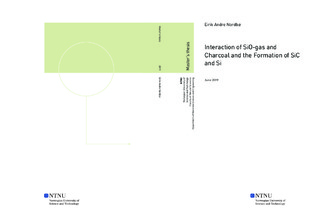| dc.contributor.advisor | Tangstad, Merete | |
| dc.contributor.author | Nordbø, Eirik Andre | |
| dc.date.accessioned | 2019-10-19T14:02:30Z | |
| dc.date.available | 2019-10-19T14:02:30Z | |
| dc.date.issued | 2019 | |
| dc.identifier.uri | http://hdl.handle.net/11250/2623366 | |
| dc.description.abstract | For å nå eit høgt utbytte i produksjonen av silisium, er det viktig å fange stigande SiO-gass ved reaksjon med karbonhaldig materialar for å danne SiC. Den påfølgjande reaksjonen mellom SiC og SiO-gass er kjend for å produsere elementær Si. Til trass for fleire studiar om anvendelegheita av trekol i silisiumsomner er kunnskapen innanfor dette feltet manglande. Nyare studiar indikerer mot en lågare temperatur for silisiumsproduksjon i SiC enn tidlegare tenkt mogleg. Målet med denne avhandlinga vil vere å utforske interaksjonen mellom SiO-gass og trekol og formasjonen av SiC. Vidare vil den lågare temperaturen for silisiumsproduksjon i SiC bli granska.
For å oppnå dette, vart ein omn med varmeelement av grafitt brukt for å varme opp grafittdiglar med SiO2/Si og trekol separert med ein gass-gjennomtrengeleg disk. Temperaturar vart valt både over og under den teoretiske minste temperaturen for Si-produksjon og eksakte temperaturar vart målt inne i ladninga av trekol.
Vist i denne oppgåva, er formasjonen av SiC og elementær Si frå trekol. Ein lineær samanheng vart funnet mellom endring i massen til trekolet når samanlikna med temperatur. Vidare viser studien ein signifikant vekst av både ein- og fleirkrystallar på både partikkeloverflater og innsida av porer. Dei ulike krystallmorfologiane, saman med resultat frå XRD-analyse, bekrefter 3C beta-SiC og indikerar til 4H alpha-SiC. Strukturelle endringar vart observert når trekol blir konvertert til SiC og krystallvekst inne i porer er tenkt til å forklare dette. Det ble òg funne elementær Si ved 1781.8 °C, ein temperatur som er under teoretisk minimum for Si-produksjon. | |
| dc.description.abstract | To achieve a high yield in the silicon production process, the capture of ascending SiO-gas by reaction with carbonaceous materials to form SiC is of great importance. The following reaction between SiC and SiO-gas is known to produce elemental Si. Although several studies on the use of charcoal in silicon furnaces exist, the knowledge within this field is lacking. Newer studies indicate a lower temperature of Si formation in SiC than previously thought possible. The goal of this thesis will be to investigate the interaction of SiO-gas and charcoal and the formation of SiC. Furthermore, the lower temperature of elemental Si formation in SiC will be investigated.
To accomplish this, a graphite resistance-heating furnace was used to heat up graphite crucibles containing SiO2/Si and charcoal separated by a gas-permeable disc. Temperatures were chosen both above and below the theoretic minimum temperature of Si production and exact temperatures were measured inside the charcoal charge.
Shown in this thesis, is the formation of SiC and elemental Si from charcoal. A linear mass change of the charcoal charge was found to occur when compared with temperature. Furthermore, this study shows a significant growth of mono- and poly-crystals both on the particle surface and inside pores. The various morphologies of these crystals, combined with XRD results, confirm 3C beta-SiC and indicate to 4H alpha-SiC. Structural changes in charcoal were observed as it converts to SiC and crystal growth inside pores is believed to have caused this. Finally, elemental Si was found to have been formed at 1781.8 °C, which is below the theoretic minimum temperature of Si formation. | |
| dc.language | eng | |
| dc.publisher | NTNU | |
| dc.title | Interaction of SiO-gas and Charcoal and the Formation of SiC and Si | |
| dc.type | Master thesis | |
